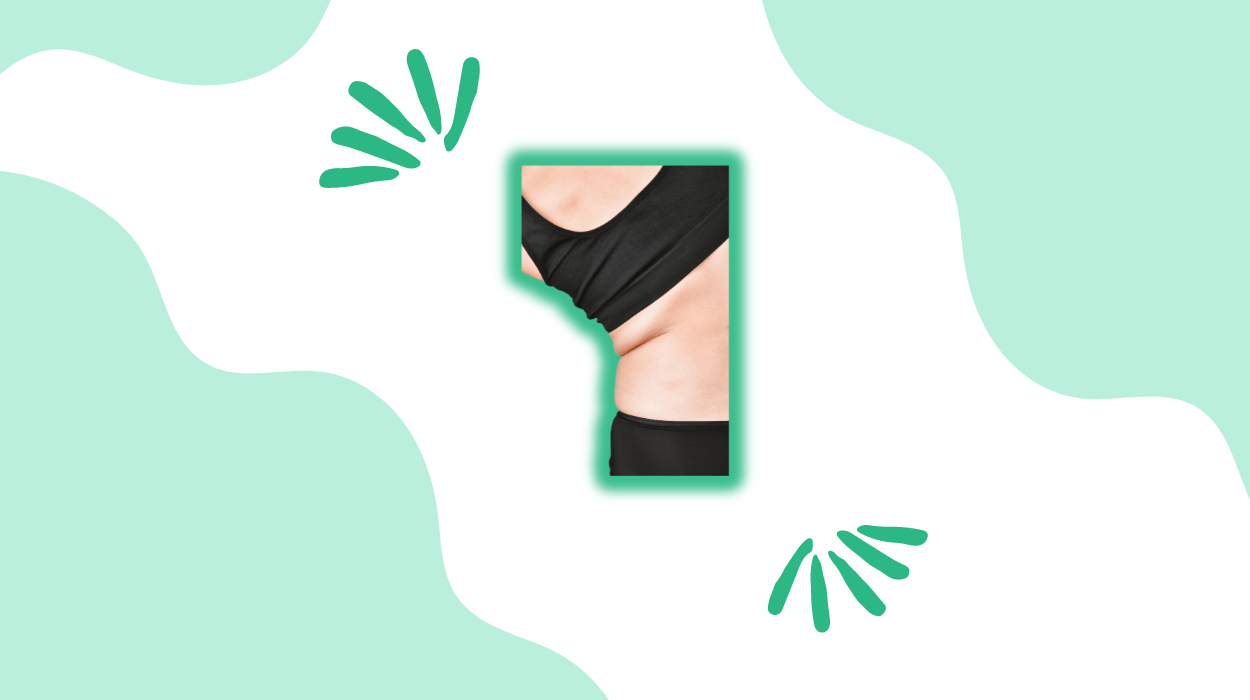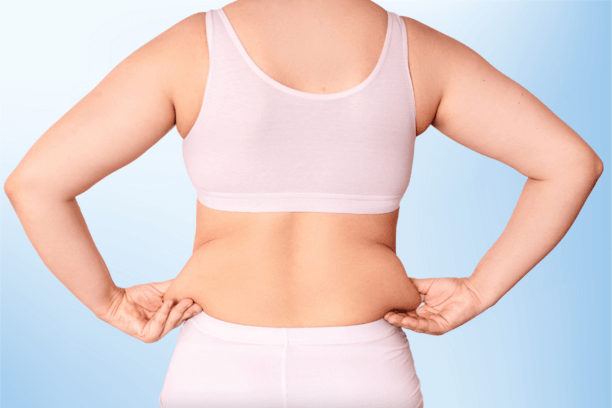

Having some back fat is normal. Body fat is necessary to maintain a normal body temperature and store sufficient energy for daily activities.
While it is very challenging to reduce fat or control where it comes off first, crash dieting or short-term remedies may not be the best approach.
Losing back requires consistently following an active lifestyle and not dabbling in extreme dieting or completely cutting out your favorite food.
Following a practical approach that works for your overall weight reduction could help reduce weight in your lower back.
This article mentions some of the best methods to support your weight loss journey. It also explains easy exercises that might help strengthen your lower back effectively.
Lower back fat is the fat accumulated between the butt and the bottom of the rib cage on the back side of your body. Many people retain the fat stored on the sides of their torso at navel height and lower back fat.
Lower back fat could be due to impaired insulin levels, carbohydrate tolerance, excessive testosterone levels, or an increased risk of metabolic disorders, PCOS, or fertility problems.

Yoga helps reduce back fat, strengthen back muscles, and support long-term weight loss. It could target the physical aspect and promote mindfulness when combined with breathing techniques.
Here are four yoga poses that might help you shed fat in your back muscles:
Research has shown that eating 20-to-25% fewer calories than you burn daily can allow you to lose fat efficiently without sacrificing muscle or experiencing excessive hunger and fatigue.
You can start decreasing your caloric intake by 300 to 500 calories daily. It could be achieved by cutting back on high-calorie, low-nutrition foods and opting for nutrient-dense options.
You could include fiber-rich foods like avocados and lean protein sources like eggs, boiled chicken breast, and salmon.
Avoid processed foods with artificial preservatives to maintain calorie intake. However, choosing low-sodium options could also help reduce water weight in the back area.
Upper back exercises may assist in reducing back fat and achieving a more defined and toned upper body. These exercises could strengthen your arms and reduce fat in those areas.
Cardio exercises may help burn calories and reduce overall body fat. Exercises like running, jogging, swimming, and jumping rope might increase your heart rate and boost your metabolism, helping you burn excess calories.
Cardiovascular exercises could release endorphins, known as “feel-good” hormones, that could elevate your mood, reduce stress, and can also boost your energy levels.
Strength training may reduce back fat and achieve a stronger, more toned physique. Building muscle contributes to weight loss and may help target and strengthen your back muscles.
Strength training exercises may target multiple muscles in your back, including the lats, rhomboids, and traps, which help enhance your overall back strength and definition.
As you increase muscle mass, your metabolism improves, increasing fat burning even at rest. Thus, strength training may improve bone density, enhance posture, and increase endurance.
Protein possesses a high thermic effect, as it needs more energy to digest than carbohydrates.
Thus, you can boost your metabolism and burn calories effectively throughout the day by increasing your protein intake.
Consuming adequate protein might allow you to achieve your weight reduction goals and reduce lower back fat effectively.
Consuming protein helps you feel fuller for more extended periods, which will curb your cravings and reduce the chance of overeating, eventually supporting your weight loss efforts.
You can consider supplements in your routine to support your weight loss journey and reduce back fat effectively. According to research, dietary supplements could boost your weight loss efforts by increasing calorie burn, enhancing fat loss, and reducing hunger and cravings. However, the evidence supporting this claim is unconvincing and inconclusive.
| Supplement | Benefits |
|---|---|
|
Caffeine |
Increases the number of calories burned and boosts strength, muscle endurance, and anaerobic performance. |
|
Yohimbine |
Might increase fat loss, particularly beneficial with losing “stubborn” fat when used in conjunction with fasted training. |
|
Phoenix |
Could speed up metabolism, enhance fat burning, and reduce hunger and cravings. |
Cycling is a cardiovascular exercise that could help burn calories and promote fat loss without putting strain on the joints. It could help create a caloric deficit essential for losing body fat.
Cycling may target your lower body muscles, such as your quadriceps, hamstrings, and glutes while engaging your core and back muscles. When you pedal, your back muscles stabilize your spine, increasing muscle tone and strength in your lower back area.
Performing a deadlift could target multiple muscles, including the lower back. It may help increase functional strength by targeting the lower body’s largest muscles.
The reverse hip raise is a low-impact exercise that may target and tone the muscles in your back. It engages the muscles in your lower back, helping to strengthen and tone them.
To perform the reverse hip raise,
The side jackknife might target the obliques and help to tone the ‘love handles’ and lower back area.
The Superman pose targets the lower back muscles. It could strengthen your lower back and glutes, helping you achieve a strong and toned physique.
The back squat engages the muscles in your legs and is effective for building strength and promoting fat loss. It also recruits your core, glutes, and back muscles, which supports overall body composition improvement.
To perform a back squat correctly, follow these steps:
Research shows that the front squat is as effective in training the quads as the back squat, even when using up to 20% less weight. The front squat places less compressive force on the knees and lower back.
Here’s how you can perform the front squat:
Recommended:
Genetics, sedentary lifestyles, poor dietary habits, hormonal imbalances, aging, lack of physical activity, stress, and hormonal changes can influence lower back fat.
Genetics helps determine where excess weight is stored in the body. However, lifestyle choices and habits could also contribute to back fat accumulation.
A sedentary lifestyle, represented by a lack of physical action, could also lead to weight gain and fat storage in the lower back area.
Poor eating habits that include a high-sodium or high-sugar diet consumption can cause inflammation in the body, making back fat more noticeable.
Hormonal imbalances and changes, which can occur during different phases of life, might affect the distribution of fat in the body, including the lower back region.
As we age, our metabolism could slow down, making it easier for fat to accumulate in certain areas, including the lower back.
Thus, choosing a comprehensive approach that combines physical activity, a nutritious diet, stress management methods, and hormonal stability is essential.
Cycling could effectively reduce lower back fat when combined with a nutritious diet and overall fitness routine. It might help burn calories and strengthen the muscles in the back, leading to fat loss and improved overall health.
Genetics, sedentary lifestyles, poor dietary habits, hormonal imbalances, aging, lack of physical activity, and stress are a few causes that contribute to lower back fat. Thus, understanding these factors may help develop effective strategies for back fat reduction.
Yes. Strength training exercises are necessary for lower back fat reduction as they help build muscle mass, increase metabolism, and promote overall fat loss.
Certain supplements like caffeine and yohimbe claim to help reduce back fat. However, you must follow a balanced diet and exercise routine for sustainable weight loss.
Reducing back fat may require constant effort and time. Thus, following a holistic approach that includes targeted exercise and healthy lifestyle modification could boost these results.
Monitoring your calorie intake, creating a weight loss goal, and managing stress levels can allow you to stay motivated and consistent during your weight reduction journey.
However, remember that spot reduction is not effective. You need to work on your overall body weight to achieve desirable outcomes.
Be mindful of your sugar intake and refined carbs, as they can contribute to unwanted weight gain, hindering your efforts to lose back fat.
You can also seek a certified dietician’s recommendation to create a diet plan that offers essential nutrients without increasing your calorie consumption.
Tyler Read earned an undergraduate academic degree from Sonoma State University, California and is a certified personal trainer (CPT) with NASM (National Academy of Sports Medicine). With over 16 years of experience, Tyler has trained clients both online and in-person.
He is passionate about helping others turn their love for fitness into a career. Tyler has worked with many local and commercial gyms before establishing his successful private personal training business, which he continues to operate.
